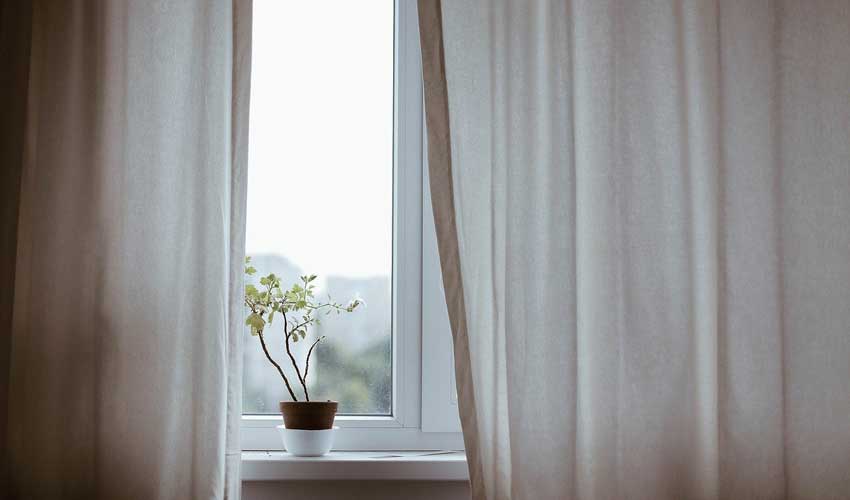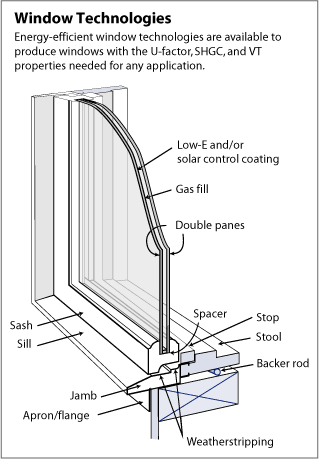The Best Energy Efficient Windows Are a Good Investment

As you might expect, the best energy efficient windows cost a fair amount more than standard, builder grade windows. Windows are critical to the character, usefulness, and enjoyment of any house. But even the best windows are the weakest link in the building envelope when it comes to keeping a house warm in winter and cool in summer. Let’s face it. Glass is a poor insulator. Even so-called insulating glass, i.e. double paned glass with an air space between the panes, only insulates about as effectively as two sheets of plywood or a hollow-core door! That’s not nearly as good as the walls of the house. From an energy standpoint, you should consider windows, including the best energy efficient windows, to be “holes” in your thermal envelope.
Certainly windows are necessary and beneficial to the design of a home, provide daylight and character to any room, and let us enjoy the beauty of the outdoors from the comfort of our homes. They constitute a significant portion of the construction costs of a home. But because windows have a major impact on the energy costs of both heating and cooling your home, you should select the best windows you can afford. In the long run, you will see a return on that investment in the form of lower fuel bills.
There have been significant improvements in glass technology in recent decades. Not too long ago, nearly every house window consisted of a single pane of glass. The energy efficiency of these windows was terrible. Single pane glass fogs up and develops frost easily. This moisture collects on the glass, runs down the glass and collects on the sash and sill causing wood rot, effectively shortening the useful life of the windows.
A major breakthrough in glass technology came with the invention of “insulated” glass. This is glass consisting of two panes of glass sealed together at the edges, trapping air between the panes. The “dead air” between the panes acts as insulation, letting the exterior pane change temperature with the outside weather, but letting the inside glass stay closer to the desired room temperature. It’s nearly impossible for frost to form on insulated glass windows.
Newer innovations in glass technology have further improved energy performance. Some glass is treated with a virtually invisible coating, creating what is known as “low-e” (low emissivity) glass. Low-e glass resists radiant heat transfer and ultra-violet radiation. Another glass type provides two insulating dead air spaces, separated by a clear polyester film or a third pane of glass. Still another glass type has argon, an inert gas, in the dead air space to improve its thermal properties.
The measure of the insulating value of a building material is expressed as an “R” value. An “R” value is the resistance to temperature transfer. The higher the “R” value, the better insulator the material is. You might here someone speak of the “U” value of glass or some other building material. The “U” value is a measure of the rate of heat transfer and is nothing more than the reciprocal, or inverse, of the “R” value. An “R” value of 4.00 would be equal to a “U” value of 0.25 (The reciprocal of 4 is 1/4 or 0.25)
Here are the “R” values for some glass types:
Single Glass R = 0.91
w/storm R = 2.00
Double insulating glass
(3/16″) air space R = 1.61
(1/4″ air space) R = 1.69
(1/2″ air space) R = 2.04
(1/2″ w/ Low-E 0.20) R = 3.13
(w/ suspended film) R = 2.77
Triple insulating glass R = 2.56
As a point of reference, a moderately insulated wall would have an R value of around 15 and a well insulated wall might have an R value of around 23. You can see how much worse an insulator even the best energy efficient windows are.
As you might imagine, the best energy efficient windows will have one of the glass options that has the highest R value (lowest U value). But glass is only part of the equation when it comes to a window’s energy performance. The best energy efficient windows must resist air infiltration. Intrinsically, fixed windows will resist air infiltration best because they are permanently sealed. Casement windows and some sliders are the tightest operable windows. This is because they have a latch that pulls the sash tight to the frame, compressing the weather stripping and closing minute air gaps. Awning windows would be the next tightest. They close tightly but often have no latch to pull them extra tight and depend on the pull of the crank to hold them closed.
Sliders without latches, double hung, and single hung windows are the least tight. This is because there must be some room for one sash to move past the other during operation limiting how snug the fit between the sash and frame.
There is a way to effectively compare energy efficiencies and find the best energy efficient window. A standard rating system has been created by the National Fenestration Rating Council, or NFRC, for short. All windows must be rated by means of standard tests for U value, Solar Heat Gain Coefficient (SHGC), Visible Transmittance, Air Leakage, and Condensation Resistance. Window manufacturers are required to post the test results on their windows by means of stickers placed on the glass stating its ratings. You can use these to compare one window’s energy performance to another.
Your Residential Building Code will have requirements for minimum acceptable ratings for your area. Or you can check the IECC Climate Zone Map to find your location and the window ratings you will need.
Your decision to exceed these ratings will be based on your budget and your desire for even more energy efficiency than the building code mandates.
With this standardized rating system, selecting the best energy efficient windows is a lot like finding the best gas mileage car by comparing gas mileage ratings. You have a standard basis for comparison.
I hope this information is helpful to you. You might want to get yourself a copy of my best-seller, Designing Your Perfect House. It is chockfull of valuable tips and advice that will save you many times the cost of the book on your house building or remodeling project. You might also like The Well-Centered Home: Simple Steps to Increase Mindfulness, Self-Awareness, and Happiness Where You Live. It will show you how to make your home a happy place.



[…] style of the home, the character of the room they’re in, and your budget. You should consider a window’s energy efficiency and durability. What window materials look best, last longest, and are easiest to maintain? What […]